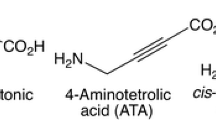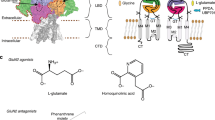Abstract
Phosphoethanolamine is a phosphomonoester that is reduced in Alzheimer disease brain. Despite its close structural similarity to GABA and the GABAB partial agonist 3-aminopropylphosphonic acid, phosphoethanolamine binds very poorly to GABAB receptors (IC50=7.5±0.8 mM). In this study, we examined whether the marked decrease in binding affinity associated with the presence of an ester oxygen in place of the α-CH2 group of GABAergic compounds also occurred in sulfonates and used high resolution solution NMR and molecular mechanics calculations to determine the structural basis of this decrease in activity. The sulfonate analog of GABA, 3-aminopropylsulfonic acid, became >2500-fold less potent when the α-CH2 was replaced by an ester oxygen. Structural studies showed that the active α-CH2 compounds (GABA, 3-aminopropylphosphonic acid, and 3-aminopropylsulfonic acid) prefer a fully extended conformation. The inactive compounds, phosphoethanolamine and ethanolamine-O-sulfate, exist in a gauche conformation around the Cβ–Cγ bond. This study, which suggests conformational differences, may explain how PE can be so efficiently excluded from GABAB receptors, despite being present in millimolar concentrations in brain. Exclusion of phosphoethanolamine from GABAB receptors may be an important physiologic control, mechanism in the regulation of inhibitory neurotransmission.
Similar content being viewed by others
Abbreviations
- 3-APP:
-
3-aminopropylphosphonic acid
- 3-APS:
-
3-aminopropylsulfonic acid
- EOS:
-
ethanolamine-O-sulfate
- GABA:
-
γ-aminobutyric acid
- PE:
-
phosphoethanolamine
- TMSP:
-
3-(trimethylsilyl)propionic-2,2,3,3-d4 acid
References
Allinger N. L. (1976) Calculation of molecular structure and energy by force-field methods.Adv. Phys. Org. Chem. 13, 1–82.
Allinger N. L. (1977) Conformational analysis 130. MM2. A hydrocarbon force field utilizing V1 and V2 torsional terms.J. Am. Chem. Soc. 99, 8127–8134.
Eliel E. L., Allinger N. L., Angyal S. J., and Morrison G. A. (1966)Conformational Analysis. Wiley, New York.
Ellison D. W., Beal M. F., and Martin J. B. (1987) Phosphoethanolamine and ethanolamine are decreased in Alzheimer’s disease and Huntington’s disease.Brain Res. 417, 389–392.
Glowiak T. and Sawka-Dobrowolska W. (1980) 3-Aminopropylphosphonic acid.Acta Cryst. B36, 961–962.
Haasnoot C. A. G., deLeeuw F. A. A. M., and Altona C. (1980) The relationship between proton-proton NMR coupling constants and substituent electronegativities—I. an empirical generalization of the Karplus equation.Tetrahedron 36, 2783–2792.
Hill D. R. and Bowery N. G. (1981)3H-Baclofen and3H-GABA bind to bicuculline-insensitive GABAB sites in rat brain.Nature 290, 149–152.
Jeffrey G. A. and Maluszynaska H. (1982) A survey of hydrogen bond geometries in the crystal structures of amino acids.Int. J. Biol. Macromol. 4, 173–185.
Karplus M. (1959) Contact electron-spin coupling of nuclear magnetic moments.J. Chem. Phys. 30, 11–15.
Kerr D. I., Ong J., Johnston G. A., and Prager R. H. (1989) GABAB-receptor-mediated actions of baclofen in rat isolated neocortical slice preparations: antagonism by phosphono-analogues of GABA.Brain. Res. 480, 312–316.
Klunk W. E., Xu C., Panchalingam K., McClure R. J., and Pettegrew J. W. (1994) Analysis of magnetic resonance spectra by mole percent: Comparison to absolute units.Neurobiol. Aging 15, 133–140.
Kraut J. (1961) The crystal structure of 2-amino-ethanol phosphate.Acta Cryst. 14, 1146–1152.
Lehmann A., Hagberg H., Nystrom B., Sandberg, M., and Hamberger A. (1985a) In vivo regulation of extracellular taurine and other neuroactive amino acids in the rabbit hippocampus.Prog. Clin. Biol. Res. 179, 289–311.
Lehmann A., Lazarewicz J. W., and Zeise M. (1985b) N-Methylaspartate-evoked liberation of taurine and phosphoethanolamine in vivo: site of release.J. Neurochem. 45, 1172–1177.
Lehmann A. (1990) Derangements in cerebral osmohomeostasis: a common denominator for stimulation of taurine and phosphoethanolamine release.Prog. Clin. Biol. Res. 351, 337–347.
McIlwain H. and Bachelard H. S. (1985)Biochemistry and the Central Nervous System, 5th ed., Churchill Livingstone, Edinburgh.
Mohamadi F., Richards N. G. J., Guida W. C., Liskamp R., Caufield C., Chang G., Hendrikson T., and Still W. C. (1990) MacroModel—an integrated soft-ware system for modeling organic and bioorganic molecules using molecular mechanics.J. Comp. Chem. 11, 440–467.
Munns A. R. I., Low J. N., Tollin P., and Young D. W. (1981) 2-Aminoethyl hydrogen sulfate (zwitterion), C2H7NO4S.Cryst. Struct. Commun. 10, 1431–1434.
Pachler K. G. R. (1964) Nuclear magnetic resonance study of some α-amino acids—II. Rotational isomerism.Spect. Acta 20, 581–587.
Steward E. G., Player R. B., and Warner D. (1973a) The crystal and molecular structure of gamma-aminobutyric acid determined at low temperature.Acta Cryst. B29, 2038–2040.
Steward E. G., Player R. B., and Warner D. (1973b) The crystal structure of gamma-aminobutyric acid hydrochloride. a refinement.Acta Cryst. B29, 2825–2826.
Stewart R. F. and Craven B. M. (1993) Molecular electrostatic potentials from crystal diffraction: The neurotransmitter γ-aminobutyric acid.Biophys. J. 65, 998–1005.
Still W. C., Tempczyk A., Hawley R. C., and Hendrickson T. (1990) Semianalytical treatment of solvation for molecular mechanics and dynamics.J. Am. Chem. Soc. 112, 6127–6129.
Swaminathan S. and Craven B. M. (1984) Electrostatic properties of phosphorylethanolamine at 123 K from crystal diffraction.Acta Cryst. B40, 511–518.
Tsukamoto S., Ogawa N., Mizuno S., and Mori A. (1975) Structure-activity relationships of 50 GABA-relatives in GABA radioreceptor assay.Neuroscience (Kobe, Japan) 8, 58,59.
Tunnicliff G. and Smith J. A. (1981) Action of analogues on gamma-aminobutyric acid recognition sites in rat brain.Neurochem. Int. 3, 371–376.
Ueoka S., Fujiwara T., and Tomita K. (1972) Crystal and molecular structure of omega-amino acids, omega-amino sulfonic acids and their derivatives. II. The crystal and molecular structure of alpha-form of 3-aminopropane sulfonic acid, homotaurine.Bull. Chem. Soc. Japan 45, 3634–3638.
Author information
Authors and Affiliations
Rights and permissions
About this article
Cite this article
Klunk, W.E., McClure, R.J., Xu, CJ. et al. Structural determinants of activity at the GABAB receptor. Molecular and Chemical Neuropathology 26, 15–30 (1995). https://doi.org/10.1007/BF02814938
Received:
Accepted:
Issue Date:
DOI: https://doi.org/10.1007/BF02814938




